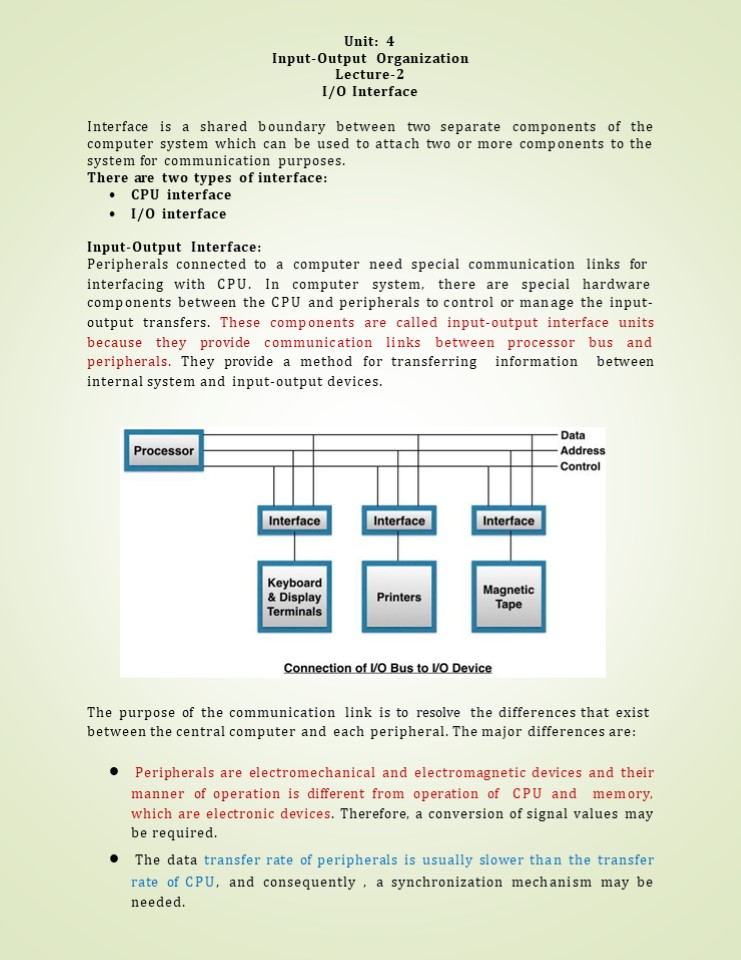input output system PowerPoint PPT Presentation
Title: input output system
1
- Unit 4
- Input-Output Organization Lecture-2
- I/O Interface
- Interface is a shared boundary between two
separate components of the computer system which
can be used to attach two or more components to
the system for communication purposes. - There are two types of interface
- CPU interface
- I/O interface
- Input-Output Interface
- Peripherals connected to a computer need
special communication links for - interfacing with CPU. In computer
system, there are special hardware - components between the CPU and peripherals to
control or manage the input- output transfers.
These components are called input-output
interface units because they provide
communication links between processor bus and
peripherals. They provide a method for
transferring information between internal
system and input-output devices.
- The purpose of the communication link is to
resolve the differences that exist between the
central computer and each peripheral. The major
differences are - Peripherals are electromechanical and
electromagnetic devices and their manner of
operation is different from operation of CPU and
memory, which are electronic devices.
Therefore, a conversion of signal values may be
required. - The data transfer rate of peripherals is usually
slower than the transfer rate of CPU, and
consequently , a synchronization mechanism may be
needed.
2
- Data codes and formats in peripherals differ from
word format in the CPU and memory. - The operating modes of peripherals are different
from each other and each must be controlled so
as not to disturb the operation of other
peripherals connected to CPU. - To resolve these differences, computer systems
include special hardware components between the
CPU and Peripherals to supervises and
synchronizes all input and out transfers. These
components are called Interface Units because
they interface between the? processor bus and the
peripheral devices. - The main function of input-output interface
circuit are - Data conversion
- Data conversion refers to conversion between
digital and analog signals and conversion
between serial and parallel data formats. - Synchronization
- Synchronization refers to matching of operating
speed of CPU and other peripherals. - Device selection
- Device selection refers to the selection of I/O
device by CPU in a queue manner. - A typical communication link between the
processor and several peripherals is shown in
fig above. - The I/O bus consists of data lines, address lines
and control lines. - The I/O bus from the processor is attached to all
peripherals interface. - To communicate with a particular device, the
processor places a device address on address
lines. - Each Interface decodes the address and control
received from the I/O bus, interprets them for
peripherals and provides signals for the
peripheral controller. It is also synchronizes
the data flow and supervises the transfer
between peripheral and processor. - Each peripheral has its own controller. For
example, the printer controller controls the
paper motion, the print timing. - The control lines are referred as I/O command.
The commands are as following - Control command- A control command is issued to
activate the peripheral and to inform it what to
do. - Status command- A status command is used to test
various status conditions in the interface and
the peripheral.
3
- Data Input command- The data input command is the
opposite of the data output. In this case the
interface receives on item of data from the
peripheral and places it in its buffer register - To communicate with I/O, the processor must
communicate with the memory unit. Like the I/O
bus, the memory bus contains data, address and
read/write control lines. - There are 3 ways that computer buses can be used
to communicate with memory and I/O - Use two Separate buses , one for memory and other
for I/O. - Use one common bus for both memory and I/O but
separate control lines for each. - Use one common bus for memory and I/O with common
control lines

